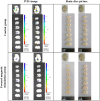Magnetothermal-based non-invasive focused magnetic stimulation for functional recovery in chronic stroke treatment
- PMID: 36973390
- PMCID: PMC10042827
- DOI: 10.1038/s41598-023-31979-w
Magnetothermal-based non-invasive focused magnetic stimulation for functional recovery in chronic stroke treatment
Abstract
Magnetic heat-based brain stimulation of specific lesions could promote the restoration of impaired motor function caused by chronic stroke. We delivered localized stimulation by nanoparticle-mediated heat generation within the targeted brain area via focused magnetic stimulation. The middle cerebral artery occlusion model was prepared, and functional recovery in the chronic-phase stroke rat model was demonstrated by the therapeutic application of focused magnetic stimulation. We observed a transient increase in blood-brain barrier permeability at the target site of < 4 mm and metabolic brain activation at the target lesion. After focused magnetic stimulation, the rotarod score increased by 390 ± 28% (p < 0.05) compared to the control group. Standardized uptake value in the focused magnetic stimulation group increased by 2063 ± 748% (p < 0.01) compared to the control group. Moreover, an increase by 24 ± 5% (p < 0.05) was observed in the sham group as well. Our results show that non-invasive focused magnetic stimulation can safely modulate BBB permeability and enhance neural activation for chronic-phase stroke treatment in the targeted deep brain area.
© 2023. The Author(s).
Conflict of interest statement
The authors declare no competing interests.
Figures









Similar articles
-
Focused magnetic stimulation for motor recovery after stroke.Brain Stimul. 2024 Sep-Oct;17(5):1048-1059. doi: 10.1016/j.brs.2024.08.011. Epub 2024 Aug 28. Brain Stimul. 2024. PMID: 39214184
-
MicroRNA-149-5p regulates blood-brain barrier permeability after transient middle cerebral artery occlusion in rats by targeting S1PR2 of pericytes.FASEB J. 2018 Jun;32(6):3133-3148. doi: 10.1096/fj.201701121R. Epub 2018 Jan 18. FASEB J. 2018. PMID: 29401609
-
An In Vivo Mouse Model to Study Blood-Brain Barrier Destabilization in the Chronic Phase of Stroke.Methods Mol Biol. 2022;2492:289-305. doi: 10.1007/978-1-0716-2289-6_17. Methods Mol Biol. 2022. PMID: 35733052
-
Direct stimulation of angiotensin II type 2 receptor initiated after stroke ameliorates ischemic brain damage.Am J Hypertens. 2014 Aug;27(8):1036-44. doi: 10.1093/ajh/hpu015. Epub 2014 Feb 26. Am J Hypertens. 2014. PMID: 24572705
-
Neuroprotective efficacy of microvascularly-localized versus brain-penetrating antioxidants.Acta Neurochir Suppl. 1996;66:107-13. doi: 10.1007/978-3-7091-9465-2_19. Acta Neurochir Suppl. 1996. PMID: 8780807 Review.
Cited by
-
Cellular Activity Modulation Mediated by Near Infrared-Irradiated Polydopamine Nanoparticles: In Vitro and Ex Vivo Investigation.ACS Nano. 2025 May 6;19(17):16267-16286. doi: 10.1021/acsnano.5c04181. Epub 2025 Apr 24. ACS Nano. 2025. PMID: 40270300 Free PMC article.
-
Microfabrication Technologies for Nanoinvasive and High-Resolution Magnetic Neuromodulation.Adv Sci (Weinh). 2024 Dec;11(46):e2404254. doi: 10.1002/advs.202404254. Epub 2024 Oct 24. Adv Sci (Weinh). 2024. PMID: 39445520 Free PMC article. Review.
-
Localized brain stimulation with mild magnetic hyperthermia promotes microglia activity towards reactive and autophagic phenotypes in vivo.Sci Rep. 2025 Jul 8;15(1):24425. doi: 10.1038/s41598-025-10441-z. Sci Rep. 2025. PMID: 40629014 Free PMC article.
-
Advances in magnetic field approaches for non-invasive targeting neuromodulation.Front Hum Neurosci. 2025 Apr 28;19:1489940. doi: 10.3389/fnhum.2025.1489940. eCollection 2025. Front Hum Neurosci. 2025. PMID: 40356879 Free PMC article. Review.
References
Publication types
MeSH terms
LinkOut - more resources
Full Text Sources
Medical

